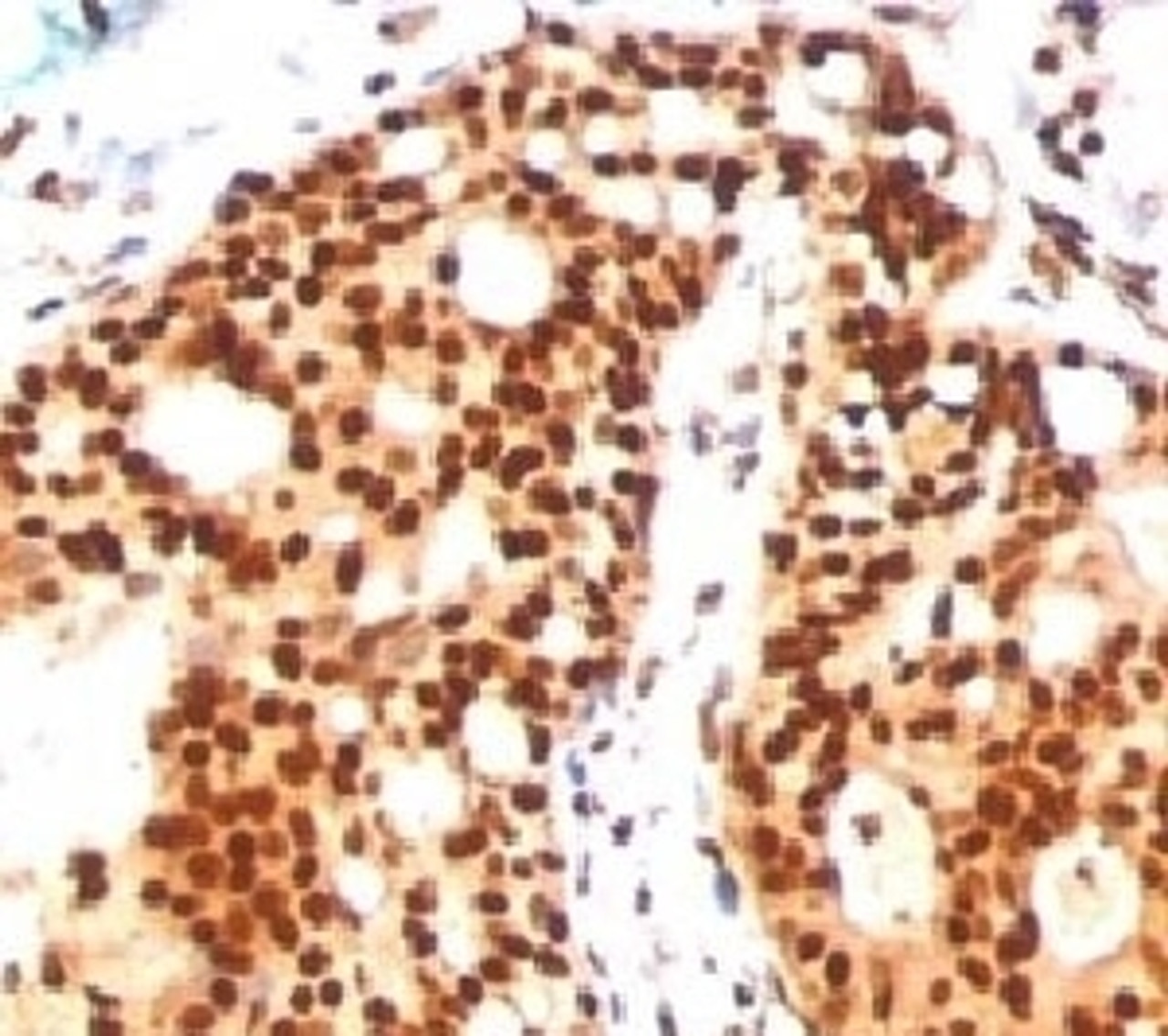Product Description
SUMO 2/3 Antibody [SM23/496] | 33-204 | ProSci
Host: Mouse
Reactivity: Human
Homology: N/A
Immunogen: Recombinant human SUMO2 protein was used as the immunogen for this SUMO2/3 antibody.
Research Area: Homeostasis
Tested Application: WB, Flow, IHC, IF
Application: Flow Cytometry: 0.5-1 ug/million cells
IF: 0.5-1 ug/ml
WB: 0.5-1 ug/ml
IHC (FFPE) : 0.5-1 ug/ml for 30 minutes at RT (1)
Prediluted format : incubate for 30 min at RT (2)
The concentration stated for each application is a general starting point. Variations in protocols, secondaries and substrates may require the SUMO2/3 antibody to be titered up or down for optimal performance.
1. Staining of formalin-fixed tissues requires boiling tissue sections in 10mM citrate buffer, pH 6.0, for 10-20 min followed by cooling at RT for 20 minutes.
2. The prediluted format is supplied in a dropper bottle and is optimized for use in IHC. After epitope retrieval step (if required) , drip mAb solution onto the tissue section and incubate at RT for 30 min.
Specificiy: N/A
Positive Control 1: N/A
Positive Control 2: N/A
Positive Control 3: N/A
Positive Control 4: N/A
Positive Control 5: N/A
Positive Control 6: N/A
Molecular Weight: N/A
Validation: N/A
Isoform: N/A
Purification: Protein G purified
Clonality: Monoclonal
Clone: SM23/496
Isotype: IgG1, kappa
Conjugate: Unconjugated
Physical State: Liquid
Buffer: PBS with 0.1 mg/ml BSA and 0.05% sodium azide
Concentration: 0.2 mg/mL
Storage Condition: Aliquot and Store at 2-8˚C. Avoid freez-thaw cycles.
Alternate Name: SUMO2/3 Antibody: HSMT3, SMT3B, SUMO3, Smt3A, SMT3H2, SMT3A, Small ubiquitin-related modifier 2, HSMT3, SUMO-2
User Note: Optimal dilutions for each application to be determined by the researcher
BACKGROUND: This antibody reacts with both SUMO2 and SUMO3. The small ubiquitin-related modifier (SUMO) proteins, which include SUMO1, 2 and 3, belong to the ubiquitin-like protein family. Like ubiquitin, the SUMO proteins are synthesized as precursors that undergo processing before conjugation to target proteins. Also, both utilize the E1, E2 and E3 cascade enzymes for conjugation. However, SUMO and ubiquitin differ with respect to targeting. Ubiquitination predominantly targets proteins for degradation, whereas sumoylation targets for a variety of cellular processing, including nuclear transport, transcriptional regulation, apoptosis and protein stability. The unconjugated SUMO1/2/3 proteins localize to the nuclear membrane, nuclear bodies and cytoplasm, respectively. SUMO1 utilizes Ubc9 for conjugation to several targets, which include MDM2, p53, PML and RanGap1. SUMO2/3 contribute to a greater percentage of protein modification than does SUMO1 and they can form polymeric chains. In addition, SUMO3 regulates beta-Amyloid generation and may be critical in the onset or progression of Alzheimer’s disease.
 Euro
Euro
 USD
USD
 British Pound
British Pound
 NULL
NULL

![SUMO 2/3 Antibody [SM23/496] SUMO 2/3 Antibody [SM23/496]](https://cdn11.bigcommerce.com/s-452hpg8iuh/images/stencil/1280x1280/products/575065/811301/porsci_lo__79508.1648973713__36460.1649091803.png?c=2)


![SUMO 2/3 Antibody [SM23/496] SUMO 2/3 Antibody [SM23/496]](https://cdn11.bigcommerce.com/s-452hpg8iuh/images/stencil/100x100/products/575065/811301/porsci_lo__79508.1648973713__36460.1649091803.png?c=2)


![SUMO 2/3 Antibody [SM23/496] SUMO 2/3 Antibody [SM23/496]](https://cdn11.bigcommerce.com/s-452hpg8iuh/images/stencil/500x659/products/575065/811301/porsci_lo__79508.1648973713__36460.1649091803.png?c=2)








